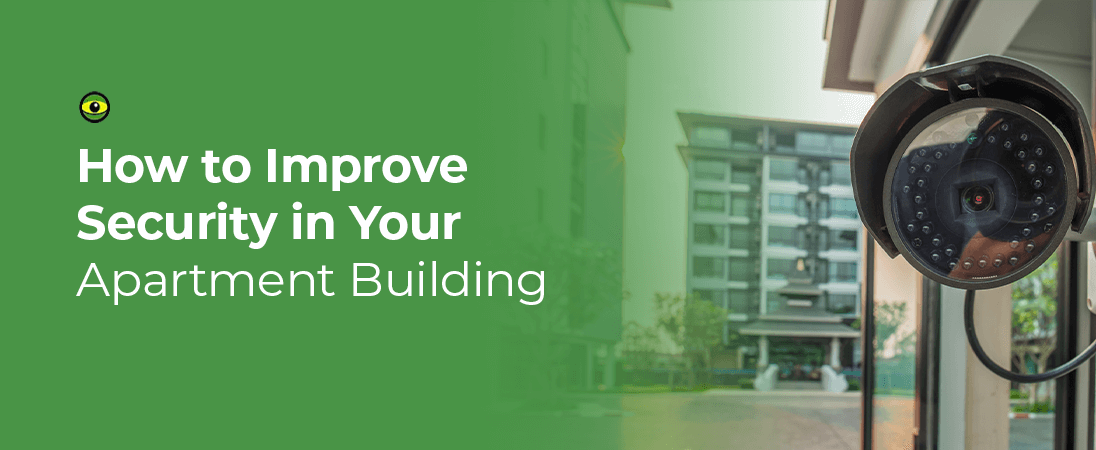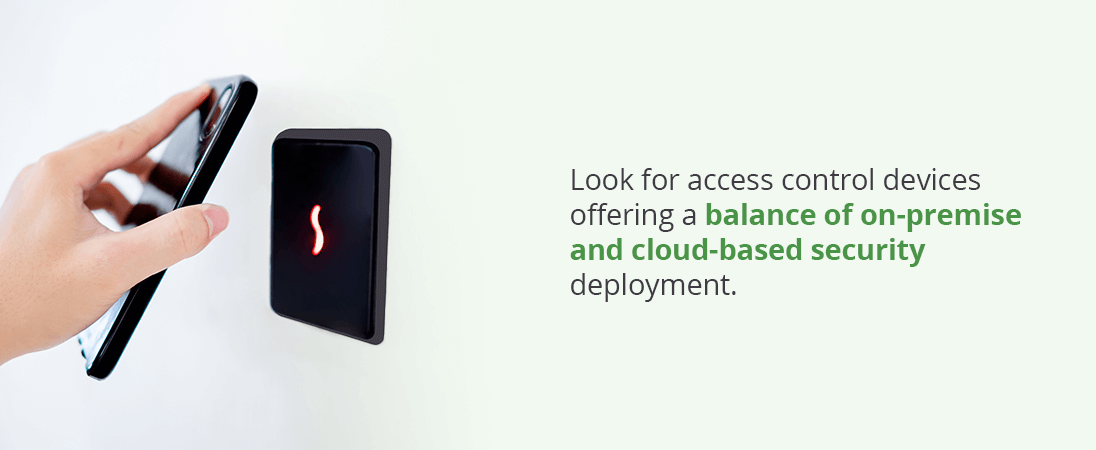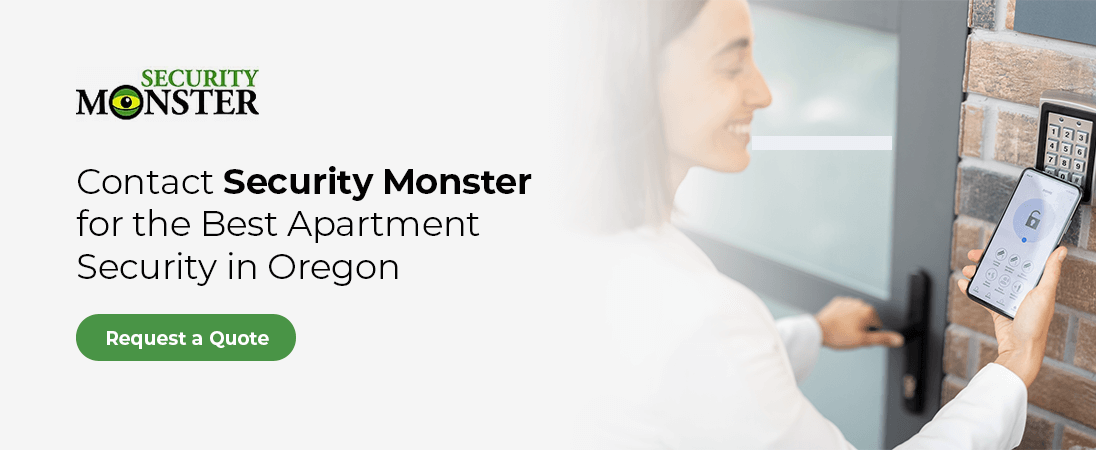How to Improve Security in Your Apartment Building

Table of Contents
- Start with a Security Risk Assessment
- Install Proper Lighting
- Install Security Cameras
- Install Access Control Features
- Encourage your Community to Get Involved
According to the FBI, property crimes happen every 4.1 seconds, with burglaries occurring every 22.6 seconds. Although many apartment complexes offer premium features like security staff and privacy gates, they are still at risk for break-ins, theft, property crime and violent crimes.
Investing in complete apartment security in Oregon will help you protect your property, structures and amenities, preserve your property’s value and reputation and give your renters peace of mind. Here’s how to secure your apartment building and see those potential benefits:
1. Start With a Security Risk Assessment
A professional security risk assessment provides an unbiased, third-party perspective on your apartment property and potential security risks you could be overlooking.
On the day of the assessment, a trained professional will check for things like:
- Scalable walls or gates
- Loose, broken or weak locks
- Windows and doors that don’t close completely
- Areas with poor lighting
- Unsupervised offices
- Ground-level windows
- Unsecured garage doors
Once they’ve completed their assessment of your entire property, including amenities and public spaces, they will work with you to create a plan of action for addressing these concerns. Depending on your property’s unique needs, this could mean making repairs, investing in security equipment, implementing 24/7 monitoring, installing access control systems, adding additional lighting or replacing locks.
2. Install Proper Lighting
Well-lit areas are often safer and encourage residents to spend more time enjoying your property’s features and amenities. Adequate lighting helps neighbors identify potential strangers while around the complex, prompting security calls when warranted. Lit areas can deter crimes better than dark alleys and shadowed corners.
Take a walk around your apartment property after dark and note the following areas:
- Parking lots
- Walkways
- Entrances
- Common rooms
- Outdoor amenities
- Laundry rooms
- Pet parks
- Fitness centers
- Business centers
- Conference rooms
- Mail and package areas
- Dumpsters and recycling
- Storage areas
Be mindful of light placement when brightening up your complex. Avoid positioning lights to shine in residents’ windows after dark, and choose a warmer, less harsh lighting in areas where it’s unavoidable. Consider sending a feedback form to residents to know which areas of the complex they feel could be better lit.
3. Install Security Cameras
Security cameras give you control over your complex by offering a full view of all public and shared areas. Seeing security cameras can deter crime and help residents feel safer. Look for a system that includes 24/7 monitoring features, real guard response, helpful customer service and smartphone apps for convenient management.
Consider installing security cameras near:
- Doors and entrances
- The lobby
- Shared areas and common rooms
- Indoor and outdoor amenities
- Hallways
- Parking lots
- Walkways
- The back and sides of buildings
- Mail and package areas
- Dumpsters and recycling
You should also consider including a section in the rental agreement allowing tenants to install a security camera near their doors so they have more control and security as wanted. Add terms specifying professional installation only if you’re worried about potential damage from do-it-yourself installations.

4. Install Access Control Features
Access control lets you and your employees choose who is authorized to access certain spaces — including lobbies, private areas, offices, amenities and complex entrances and exits — and when that access is valid or revoked. Look for access control devices offering a balance of on-premise and cloud-based security deployment.
Some common examples of access control features for apartment complexes include:
- Key fobs: Key fobs are small, handheld remotes for keyless entry to doors, similar to the ones you might use to lock and unlock your car or pop the trunk. They’re easy to use, compact and can be programmed as multifunctional.
- Magnetic door locks: Magnetic door systems pair with keypad entry systems, credential readers or push bars to offer a strong protective field when doors are locked and unlocked. They are ideal for single doors requiring moderate security without constant monitoring, such as resident-only amenities, glass doors or emergency exits.
- Intercom systems: SIP and network-based intercom systems let your team communicate with each other and guests via voice and sometimes camera, depending on your system. You can control who gets access, see those requesting entry and easily deliver complex-wide messages to staff. Intercoms are a good tool for deterring unauthorized access and property crimes.
- Gate control: Gate control systems let you operate security and entrance gates from a remote location, like the security office, from a smartphone or computer. Automatic and controlled gates are often safer than manual ones, as they aren’t as easily broken through or bypassed. They can also simplify entry and exit for residents.
- Mobile credentials: Mobile credential access control makes it easy for employees to pass through security with a Bluetooth credential directly from their smartphone or mobile device. This level of convenience makes it easier for them to respond to resident requests while still providing you full visibility regarding who is accessing doors and when.
Pair an access control system with 24/7 security monitoring for around-the-clock support. Hiring professional security monitoring also frees up staff to focus on other areas of daily operations, like tenant questions, repairs, noise complaints or general complex upkeep.
5. Encourage Your Community to Get Involved
Encourage your community to take an active part in making the complex as safe as possible with things like:
- Resident events: Host regular resident events in your complex’s shared spaces, like the lobby or conference room, and encourage tenants to get to know their neighbors. This will make it easier for tenants to identify suspicious activity and foster a sense of community where residents can keep an eye out for one another.
- Helplines and hotlines: Set up a direct helpline or hotline for residents to contact your security team if there’s a suspected disturbance or suspicious activity to report. Ensure tenants have 24/7 access to a member of your team to report potential threats and get immediate assistance as needed.
- Emergency contact information: Include a list of all local emergency contact information in each resident’s move-in packet, including the phone numbers and addresses for the local police, ambulance, fire department and animal control. Consider working with companies to offer move-in coupons encouraging residents to invest in security equipment for their own apartments.
Contact Security Monster for the Best Apartment Security in Oregon
Get personalized recommendations for securing your apartment building with features like 24/7 monitoring, mobile credentials, business upgrades and more at Security Monster. Our team is here to help you choose the best security package for your complex so you and your residents can sleep easier at night. Request your quote or, give us a call at 541-342-8111

